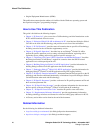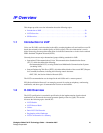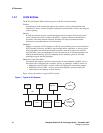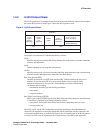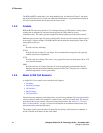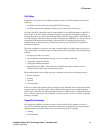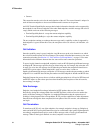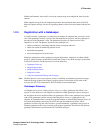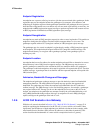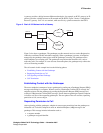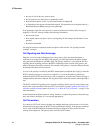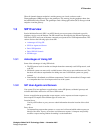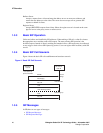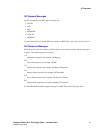34 Dialogic
®
Global Call IP Technology Guide — November 2007
Dialogic Corporation
IP Overview
• Connect
This connection remains active for the entire duration of the call. The control channel is unique for
each call between endpoints so that several different media streams can be present.
An H.245 TerminalCapabilitySet message that includes information about the codecs supported by
that endpoint is sent from one endpoint to the other. Both endpoints send this message and wait for
a reply which can be one of the following messages:
• TerminalCapabilitySetAck - accept the remote endpoints capability
• TerminalCapabilitySetReject - reject the remote endpoints capability
The two endpoints continue to exchange these messages until a capability set that is supported by
both endpoints is agreed. When this occurs, the next phase of the call scenario, call initiation, can
begin.
Call Initiation
Once the capability setup is agreed, endpoint A and B must set up the voice channels over which
the voice data (media stream) will be exchanged. The scenario described here assumes a slow start
connection procedure. See Section 4.2, “Fast and Slow Call Setup Modes”, on page 115 for more
information on the difference between the slow start and fast start connection procedure.
To open a logical channel at endpoint B, endpoint A sends an H.245 OpenLogicalChannel message
to endpoint B. This message specifies the type of data being sent, for example, the codec that will
be used. For voice data, the message also includes the port number that endpoint B should use to
send RTCP receiver reports. When endpoint B is ready to receive data, it sends an
OpenLogicalChannelAck message to endpoint A. This message contains the port number on which
endpoint A is to send RTP data and the port number on which endpoint A should send RTCP data.
Endpoint B repeats the process above to indicate which port endpoint A will receive RTP data and
send RTCP reports to. Once these ports have been identified, the next phase of the call scenario,
data exchange, can begin.
Data Exchange
Endpoint A and endpoint B exchange information in RTP packets that carry the voice data.
Periodically, during this exchange both sides send RTCP packets, which are used to monitor the
quality of the data exchange. If endpoint A or endpoint B determines that the expected rate of
exchange is being degraded due to line problems, H.323 provides capabilities to make adjustments.
Once the data exchange has been completed, the next phase of the call scenario, call termination,
can begin.
Call Termination
To terminate an H.323 call, one of the endpoints, for example, endpoint A, hangs up. Endpoint A
must send an H.245 CloseLogicalChannel message for each channel it has opened with endpoint B.
Accordingly, endpoint B must reply to each of those messages with a CloseLogicalChannelAck
message. When all the logical channels are closed, endpoint A sends an H.245



